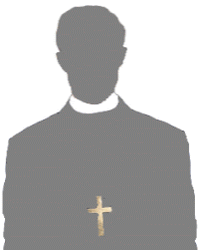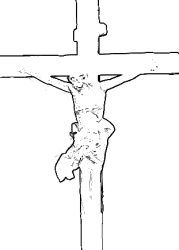Roman Catholic
St Sigismund parish
05-507 Słomczyn
85 Wiślana Str.
Konstancin deanery
Warsaw archdiocese, Poland
full list:
displayClick to display full list

searchClick to search full list by categories
wyświetlKliknij by wyświetlić pełną listę po polsku

szukajKliknij by przeszukać listę wg kategorii po polsku

Martyrology of the clergy — Poland
XX century (1914 – 1989)
personal data

surname
BIEŁOHOŁOWY
surname
versions/aliases
BIEŁOGŁOWY
forename(s)
Joseph (pl. Józef)

function
diocesan priest
creed
Latin (Roman Catholic) Church RCmore on
en.wikipedia.org
[access: 2014.09.21]
diocese / province
Mogilev archdiocesemore on
en.wikipedia.org
[access: 2013.06.23]
academic distinctions
Sacred Theology MA
Canon Law MA
nationality
Belarusian
date and place
of death
1928

Moscowtoday: Moscow city, Russia
more on
en.wikipedia.org
[access: 2020.07.31]
details of death
In 1913 because of refusal to pray at the end of religious celebrations for the Russian tsar sent — listened to lectures at Rome and Innsbruck universities.
For the first time arrested by the Russians in 1918.
Jailed in Smolensk prison without a trial for about a year.
In 01.1921 arrested for a short time again.
And in the same year arrested yet again.
On 18.02.1922 sentenced by the „16th Army court” — for „espionage for Poland” — for 5 years of slave labour.
At the end of 1922 sentenced got reduced to a year of slave labour.
Released early on 22.12.1922.
For the last time arrested by the Russians on 26(28).08.1926 in Mogilev, together with Fr Leonid Fiodorov, exarch of the Russian Greek Catholic Church.
Accused of „counter–revolutionaryanti–Soviet and anti–Russian activities, spying for Vatican, Poland and France and organization of 'Young Philarets' group”.
In 09.1926 transferred to Moscow prison.
There on 22(29).11.1926 sentenced — pursuant to Art. 61 and 66 of the Penal Code, by the Russian GPU kangaroo court, known as «GPU Troika», without a trial — to 5 years of slave labour.
On 19.12.1926 transported to ITL SLON Solovetsky Islands concentration camp.
On 19.12.1927 taken back to Moscow.
There murdered in Lyublyanka prison, ostensibly „during an escape attempt”.
alt. details of death
According to some source was in 1928 held in concentration camp on Kerch peninsula (Ukraine).
cause of death
murder
perpetrators
Russians
sites and events
Moscow (Lubyanka)Click to display the description, ITL SLONClick to display the description, GulagClick to display the description, Moscow (Butyrki)Click to display the description
date and place
of birth
11.02.1883

Sankt Petersburgtoday: Saint Petersburg city, Russia
more on
en.wikipedia.org
[access: 2020.07.31]
alt. dates and places
of birth
23.02.1883
presbyter (holy orders)
ordination
1906

positions held
1923 – 1926
dean — Mohylew / Horkideanery names/seats
today: Mogilev reg., Belarus RC deanery
1918 – 1926
parish priest — Mogilevtoday: Mogilev dist., Mogilev reg., Belarus
more on
en.wikipedia.org
[access: 2022.01.06] ⋄ Assumption of the Blessed Virgin Mary and St Stanislav the Bishop and Martyr RC archcathedral parish ⋄ Mohylew / Horkideanery names/seats
today: Mogilev reg., Belarus RC deanery
1913 – 1918
lecturer — Sankt Petersburgtoday: Saint Petersburg city, Russia
more on
en.wikipedia.org
[access: 2020.07.31] ⋄ canon and civil law, Imperial Roman Catholic Spiritual Academy (1842‐1918)
1916 – 1917
prefect — Sankt Petersburgtoday: Saint Petersburg city, Russia
more on
en.wikipedia.org
[access: 2020.07.31] ⋄ Tsar Nicholas I Civil Institute of Architecture
1916 – 1917
prefect — Sankt Petersburgtoday: Saint Petersburg city, Russia
more on
en.wikipedia.org
[access: 2020.07.31] ⋄ Nikolaev Artillery School
1916 – 1917
prefect — Sankt Petersburgtoday: Saint Petersburg city, Russia
more on
en.wikipedia.org
[access: 2020.07.31] ⋄ Constantine Artillery School
till c. 1913
student — Innsbrucktoday: Innsbruck‐Land dist., Tyrol state, Austria
more on
en.wikipedia.org
[access: 2024.03.19] ⋄ Leopold and Francis University
student — Rometoday: Rome prov., Lazio reg., Italy
more on
en.wikipedia.org
[access: 2021.12.18]
from 1910
resident — Sankt Petersburgtoday: Saint Petersburg city, Russia
more on
en.wikipedia.org
[access: 2020.07.31] ⋄ St Catherine of Alexandria the Virgin and Martyr RC parish ⋄ Sankt Petersburgtoday: Saint Petersburg city, Russia
more on
en.wikipedia.org
[access: 2020.07.31] RC deanery — appointed lecturer of the Metropolitan Theological Seminary
1907 – 1910
prefect — Smolensktoday: Smolensk oblast, Russia
more on
en.wikipedia.org
[access: 2022.01.06] ⋄ Immaculate Conception of the Blessed Virgin Mary RC parish — in gymnasium for boys and realschule
till 1907
student — Sankt Petersburgtoday: Saint Petersburg city, Russia
more on
en.wikipedia.org
[access: 2020.07.31] ⋄ philosophy and theology, Imperial Roman Catholic Spiritual Academy (1842‐1918) — postgraduate specialised studies crowned with a Sacred Theology Master's degree
till 1903
student — Sankt Petersburgtoday: Saint Petersburg city, Russia
more on
en.wikipedia.org
[access: 2020.07.31] ⋄ philosophy and theology, Metropolitan Theological Seminary
sites and events
descriptions
Moscow (Lubyanka): Location of a murderous Russian Cheka and next GPU and NKVD (later MVD and KGB) organisations and a prison (in the basement, with 118 cells — in 1936 — of which 94 were solitary — altogether at any time up to 350 prisoners were held there and c. 2,857 in 1937) in Moscow at Lubyanka Square where Russians interrogated and murdered many political prisoners. Most of the prisoners after investigations were transferred to other Moscov prisons, e.g. Butyrki. (more on: en.wikipedia.orgClick to attempt to display webpage
[access: 2014.10.31])
ITL SLON: Russian Rus. Исправи́тельно‐Трудово́й Ла́герь (Eng. Corrective Labor Camp) ITL Rus. Солове́цкий ла́герь осо́бого назначе́ния Ла́герь (Eng. Solovetsky Special Purpose Camp) SLON — concentration and slave forced labor camp (within what was to become Gulag complex) — headquartered in Solovetsky Islands in Arkhangelsk Oblast. Founded on 13.10.1923 in a famous Orthodox monastery. In the 1920s, one of the first and largest concentration camps in Russia. The place of slave labor of prisoners — at forest felling, sawmills, peat extraction, fishing, loading work on the Murmansk Railway Main Line, in road construction, production of food and consumer goods, at the beginning of the construction of the White Sea ‐ Baltic canal, etc. The concept of the later system of Russian Gulag concentration camps prob. had its origins in the Solovetsky Islands camp — from there the idea spread to the camps in the area covered by the construction of the White Sea ‐ Baltic canal, i.e. ITL BelBaltLag, and from there further, to the entire territory of the Russian state. From the network of camps on the Solovetsky Islands — also called the Solovetsky Islands archipelago — prob. also comes the concept of the „Gulag Archipelago” created by Alexander Solzhenitsyn. It is estimated that tens to hundreds of thousands of prisoners passed through the Solovetsky Islands concentration camps. At its peak, c. 72,000 prisoners were held there: e.g. 14,810 (12.1927); 12,909 (03.1928); 65,000 (1929); 53,123 (01.01.1930); 63,000 (01.06.1930); 71,800 (01.01.1931); 15,130 (1932); 19,287 (1933) — c. 43,000 of whom were murdered, including the years 1937‐1938 when c. 9,500 prisoners were transported from the camp and murdered in several places of mass executions, including Sandarmokh, Krasny Bor and Lodeynoye Polye. Among them were many Catholic and Orthodox priests. After the National Socialist Party came to power in Germany in 1933, a German delegation visited the ITL SLON camp, to „inspect” Russian solutions and adopt them later in German concentration camps. It operated until 04.12.1933, with a break from 16.11.1931 to 01.01.1932, when it was part of and later became a subcamp of the ITL BelBaltLag camp. It operated as such until 1939 (from 1936 as a prison). (more on: old.memo.ruClick to attempt to display webpage
[access: 2024.04.08])
Gulag: The acronym Gulag comes from the Rus. Главное управление исправительно‐трудовых лагерей и колоний (Eng. Main Board of Correctional Labor Camps). The network of Russian concentration camps for slave labor was formally established by the decision of the highest Russian authorities on 27.06.1929. Control was taken over by the OGPU, the predecessor of the genocidal NKVD (from 1934) and the MGB (from 1946). Individual gulags (camps) were often established in remote, sparsely populated areas, where industrial or transport facilities important for the Russian state were built. They were modeled on the first „great construction of communism”, the White Sea‐Baltic Canal (1931‐1932), and Naftali Frenkel, of Jewish origin, is considered the creator of the system of using forced slave labor within the Gulag. He went down in history as the author of the principle „We have to squeeze everything out of the prisoner in the first three months — then nothing is there for us”. He was to be the creator, according to Alexander Solzhenitsyn, of the so‐called „Boiler system”, i.e. the dependence of food rations on working out a certain percentage of the norm. The term ZEK — prisoner — i.e. Rus. заключенный‐каналоармец (Eng. canal soldier) — was coined in the ITL BelBaltLag managed by him, and was adopted to mean a prisoner in Russian slave labor camps. Up to 12 mln prisoners were held in Gulag camps at one time, i.e. c. 5% of Russia's population. In his book „The Gulag Archipelago”, Solzhenitsyn estimated that c. 60 mln people were killed in the Gulag until 1956. Formally dissolved on 20.01.1960. (more on: en.wikipedia.orgClick to attempt to display webpage
[access: 2024.04.08])
Moscow (Butyrki): Harsh transit and interrogation prison in Moscow — for political prisoners — where Russians held and murdered thousands of Poles. Founded prob. in XVII century. In XIX century many Polish insurgents (Polish uprisings of 1831 and 1863) were held there. During Communist regime a place of internment for political prisoners prior to a transfer to Russian slave labour complex Gulag. During the Great Purge c. 20,000 inmates were held there at any time (c. 170 in every cell). Thousands were murdered. (more on: en.wikipedia.orgClick to attempt to display webpage
[access: 2020.05.01])
sources
personal:
biographies.library.nd.eduClick to attempt to display webpage
[access: 2014.12.20], www.eduteka.plClick to attempt to display webpage
[access: 2014.12.20], ru.openlist.wikiClick to attempt to display webpage
[access: 2019.02.02], catholic.ruClick to attempt to display webpage
[access: 2019.02.02], ru.openlist.wikiClick to attempt to display webpage
[access: 2019.02.02]
bibliographical:
„Fate of the Catholic clergy in USSR 1917‐1939. Martyrology”, Roman Dzwonkowski, SAC, ed. Science Society KUL, 2003, Lublin
LETTER to CUSTODIAN/ADMINISTRATOR
If you have an Email client on your communicator/computer — such as Mozilla Thunderbird, Windows Mail or Microsoft Outlook, described at WikipediaPatrz:
en.wikipedia.org, among others — try the link below, please:
LETTER to CUSTODIAN/ADMINISTRATORClick and try to call your own Email client
If however you do not run such a client or the above link is not active please send an email to the Custodian/Administrator using your account — in your customary email/correspondence engine — at the following address:

giving the following as the subject:
MARTYROLOGY: BIEŁOHOŁOWY Joseph
To return to the biography press below:
 Click to return to biography
Click to return to biography







